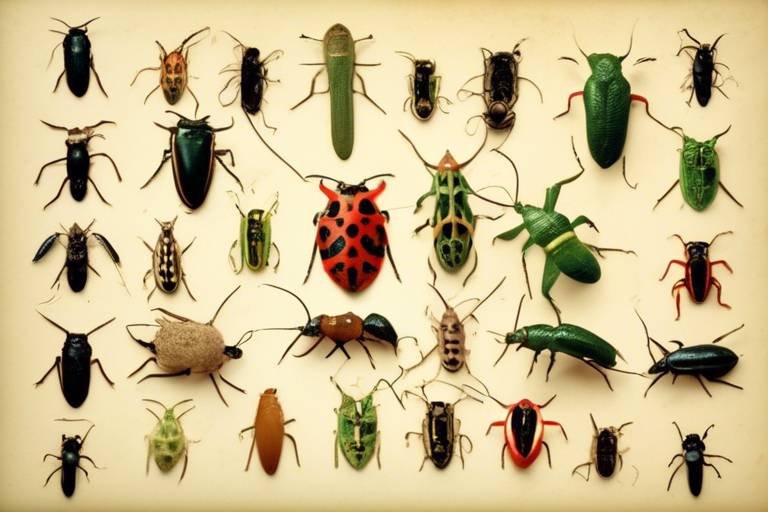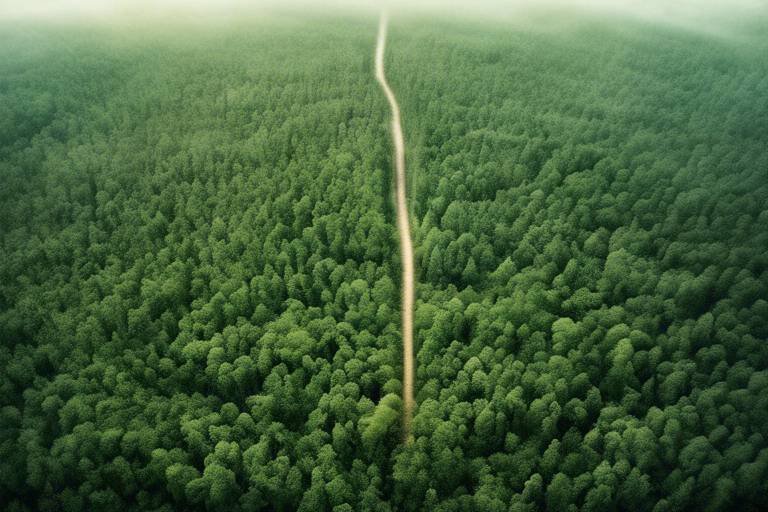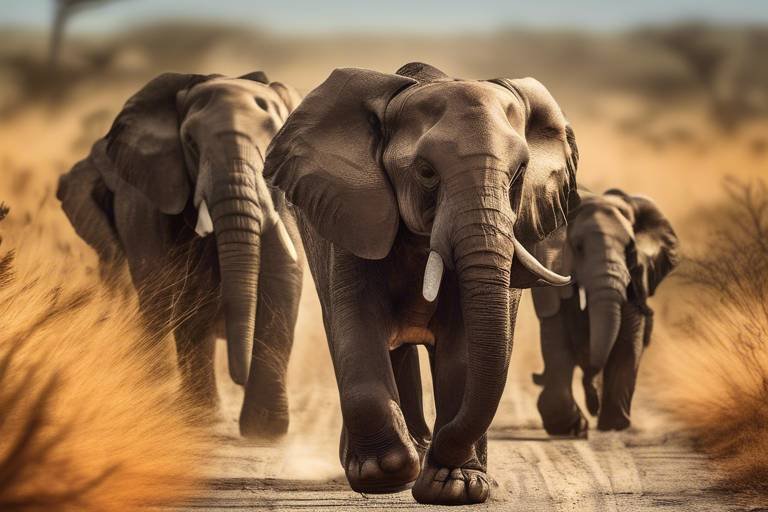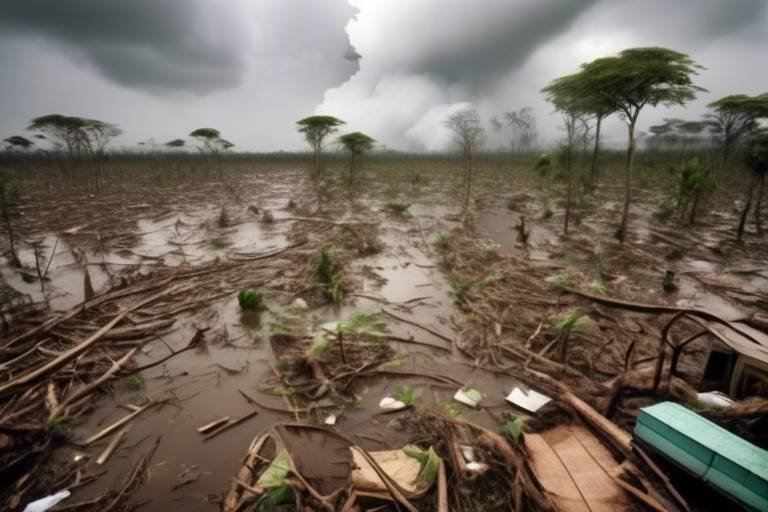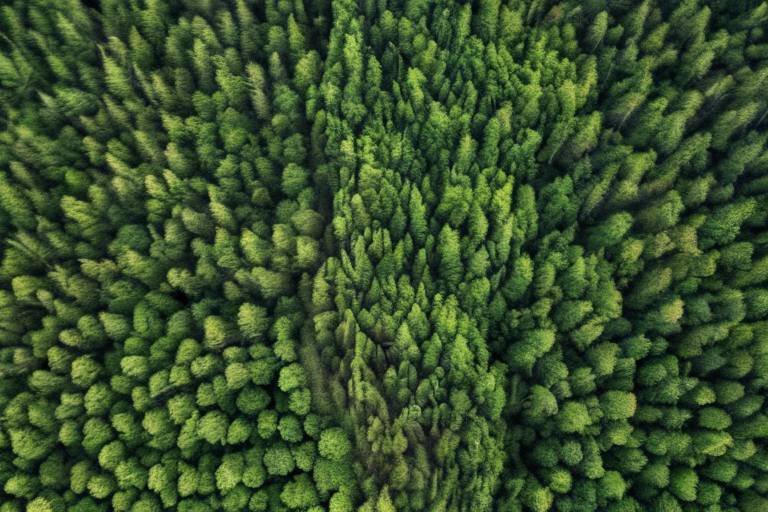The Role of Indigenous Communities in Biodiversity Conservation
This article explores how Indigenous communities contribute to biodiversity conservation, highlighting their traditional knowledge, sustainable practices, and the challenges they face in protecting their ecosystems. Indigenous peoples have been stewards of their environments for millennia, and their unique relationship with nature offers invaluable insights into sustainable living. By integrating their cultural practices and ecological wisdom, they not only preserve biodiversity but also enhance the resilience of ecosystems against various threats.
Indigenous communities possess a wealth of traditional ecological knowledge (TEK) that enhances biodiversity conservation efforts. This knowledge is often rooted in centuries of interaction with local ecosystems, providing insights into sustainable resource management. For example, many Indigenous groups have developed a profound understanding of local flora and fauna, which informs their practices in fishing, hunting, and farming. This intricate knowledge is often passed down through generations, encapsulating a deep respect for nature and its cycles. In many ways, TEK acts as a living library of ecological wisdom, offering strategies that can inform contemporary conservation efforts.
Many Indigenous groups employ sustainable land management practices that promote biodiversity. These practices include rotational farming, agroforestry, and controlled burning, which help maintain ecological balance while supporting their livelihoods. By adhering to methods that prioritize the health of the land, Indigenous communities are able to cultivate crops without depleting resources. For instance, rotational farming allows the soil to recover and regenerate, reducing the need for chemical fertilizers that can harm the ecosystem. Such practices not only sustain their communities but also contribute to broader environmental health.
Agroecological practices used by Indigenous communities foster biodiversity by integrating agricultural and ecological systems. This approach enhances soil health, supports pollinators, and promotes a diverse range of crops. By viewing agriculture as part of a larger ecosystem, Indigenous farmers can create more resilient food systems. The emphasis on biodiversity in these practices means that a variety of crops can thrive, which is crucial for food security. The interconnectedness of species within these systems also helps to mitigate the impacts of pests and diseases, creating a more stable agricultural environment.
Indigenous farmers often cultivate a variety of crops, which contributes to genetic diversity and resilience against pests and climate change. This biodiversity is crucial for food security and ecosystem stability. By growing multiple varieties of the same crop, they can ensure that at least some will survive adverse conditions, such as drought or disease. This practice is akin to having a safety net; it protects against the unpredictability of nature. Furthermore, the diverse crops support a wider range of wildlife, creating a vibrant ecosystem that benefits all species involved.
Indigenous communities actively participate in wildlife conservation through habitat protection and sustainable hunting practices. Their traditional customs often emphasize respect for wildlife, leading to healthier ecosystems. For example, many Indigenous cultures have rituals and regulations that govern hunting seasons and techniques, ensuring that animal populations remain sustainable. This holistic view of conservation recognizes that humans are a part of the ecosystem, and their actions can either harm or help the balance of nature.
Many Indigenous groups have initiated their own conservation projects to protect biodiversity. These community-led initiatives often prioritize local needs and incorporate traditional knowledge into conservation strategies. By taking charge of their conservation efforts, Indigenous communities can tailor strategies that reflect their unique cultural and ecological contexts. This autonomy not only empowers the communities but also leads to more effective conservation outcomes. When locals are involved in decision-making, the solutions are often more sustainable and culturally relevant.
Despite their contributions, Indigenous communities face numerous challenges, including land dispossession, climate change, and loss of traditional knowledge. Addressing these issues is vital for the continued role of Indigenous peoples in biodiversity conservation. The struggle for land rights is particularly pressing, as many Indigenous communities are fighting to reclaim their ancestral territories. Without secure land rights, their ability to manage and protect ecosystems is severely compromised.
Securing land rights is crucial for Indigenous communities to effectively manage and protect their territories. Legal recognition of these rights can empower communities to engage in conservation efforts. When Indigenous peoples have control over their land, they can implement sustainable practices that benefit both their communities and the environment. This is not just about protecting nature; it’s about preserving cultures, identities, and ways of life that have existed for generations.
Climate change poses significant threats to Indigenous ways of life and biodiversity. Understanding these impacts is essential for developing adaptive strategies that align with Indigenous knowledge and practices. As weather patterns shift and ecosystems change, Indigenous communities are often on the frontline, experiencing these changes firsthand. Their traditional knowledge can provide valuable insights into adaptation strategies, but they must be supported by broader societal efforts to combat climate change.
- What is Traditional Ecological Knowledge?
It refers to the understanding and practices developed by Indigenous peoples over generations regarding their local ecosystems. - How do Indigenous practices benefit biodiversity?
Indigenous practices often promote sustainable land use, crop diversity, and wildlife conservation, which collectively enhance biodiversity. - What challenges do Indigenous communities face?
They face issues such as land dispossession, climate change impacts, and the loss of traditional knowledge.

Traditional Ecological Knowledge
Indigenous communities possess a wealth of (TEK) that significantly enhances biodiversity conservation efforts. This knowledge is not just a collection of facts; it is a profound understanding of the intricate relationships between living organisms and their environments, honed over centuries of interaction with local ecosystems. Imagine having a deep-rooted connection to the land that allows you to predict weather patterns, identify medicinal plants, and understand the migration habits of animals—all skills that have been passed down through generations.
TEK is often characterized by its holistic approach, where everything is interconnected. For instance, Indigenous peoples recognize that the health of the soil directly influences the health of plants, which in turn affects the animals that depend on those plants. This cyclical understanding fosters a sense of stewardship, compelling communities to manage their resources sustainably. They often use methods that may seem primitive to outsiders but are incredibly effective in maintaining ecological balance. Some of these methods include:
- Observational Skills: Indigenous peoples closely observe the changes in their environment, allowing them to adapt their practices in response to natural fluctuations.
- Seasonal Knowledge: Knowledge of seasonal cycles aids in the timing of planting, harvesting, and hunting, ensuring that these activities align with the rhythms of nature.
- Species Interdependence: Understanding the relationships between different species helps in maintaining biodiversity and ecosystem health.
Furthermore, TEK is not static; it evolves as communities face new challenges. For example, as climate change alters weather patterns, Indigenous peoples are adapting their traditional practices to ensure resilience. This adaptability is crucial, as it allows them to continue utilizing their knowledge while also innovating solutions to contemporary environmental issues.
One striking example of TEK in action is the use of controlled burns in forest management. Indigenous communities have long practiced this technique to reduce the risk of larger wildfires, promote the growth of certain plant species, and enhance habitat for various wildlife. This practice not only benefits the environment but also demonstrates a proactive approach to conservation that is often overlooked by modern land management strategies.
In summary, traditional ecological knowledge is a vital asset in the fight for biodiversity conservation. It encapsulates a deep understanding of ecological relationships and sustainable practices that have stood the test of time. As we face global environmental challenges, it is essential that we recognize and incorporate Indigenous knowledge into broader conservation efforts. By doing so, we not only honor the wisdom of Indigenous peoples but also enhance our collective ability to protect the planet.

Sustainable Land Management Practices
When we think about the intricate relationship between Indigenous communities and their environment, it's fascinating to see how their have evolved over generations. These practices are not just about survival; they are a testament to a deep understanding of ecological balance. Imagine walking through a lush forest where every tree, plant, and animal plays a role in a finely tuned orchestra of life. That’s the essence of how Indigenous peoples manage their lands. They utilize a variety of techniques that not only support their livelihoods but also enhance the biodiversity around them.
For instance, many Indigenous groups practice rotational farming, a method that involves alternating the crops grown in a particular area to prevent soil depletion and promote fertility. This technique is akin to giving the land a chance to rest and rejuvenate, much like how we take breaks to recharge. Additionally, agroforestry is another sustainable practice where trees are integrated into agricultural landscapes. This not only provides shade and reduces soil erosion but also creates habitats for various species, contributing to a thriving ecosystem.
Another remarkable method employed by these communities is controlled burning. This practice is often misunderstood, but it’s a traditional technique used to manage landscapes. By intentionally setting small, controlled fires, Indigenous peoples can clear underbrush, promote new growth, and reduce the risk of larger, uncontrolled wildfires. It’s a bit like pruning a plant to encourage healthier growth. The result is a landscape that is not only more resilient but also rich in biodiversity.
To illustrate the effectiveness of these practices, let’s take a look at the following table that summarizes some key sustainable land management techniques used by Indigenous communities:
| Practice | Description | Benefits |
|---|---|---|
| Rotational Farming | Alternating crops in a specific area to maintain soil health. | Prevents soil depletion, enhances fertility. |
| Agroforestry | Integrating trees into farming systems. | Reduces erosion, provides habitats, increases biodiversity. |
| Controlled Burning | Intentional small-scale fires to manage land. | Promotes new growth, reduces wildfire risk. |
These sustainable practices are not just beneficial for the environment; they also play a crucial role in the cultural identity of Indigenous peoples. Their connection to the land goes beyond mere survival; it is intertwined with their traditions, spirituality, and community values. When Indigenous communities engage in sustainable land management, they are not only preserving their way of life but also contributing significantly to the global efforts of biodiversity conservation.
However, it’s important to recognize that these practices are often challenged by external pressures. Issues such as land dispossession and climate change threaten the very systems that have been in place for centuries. Thus, supporting Indigenous rights and recognizing their knowledge is essential for the future of biodiversity conservation.
- What is the importance of traditional ecological knowledge? Traditional ecological knowledge is vital as it encompasses centuries of understanding about local ecosystems, which aids in sustainable resource management.
- How do Indigenous practices contribute to biodiversity? Indigenous practices promote biodiversity through techniques like rotational farming and agroforestry that enhance soil health and create diverse habitats.
- What challenges do Indigenous communities face? Challenges include land dispossession, climate change, and loss of traditional knowledge, all of which threaten their sustainable practices.

Agroecology and Biodiversity
Agroecology is not just a farming technique; it's a holistic approach that intertwines agriculture with ecological principles, and Indigenous communities have been masters of this art for generations. By understanding the intricate relationships between plants, animals, and the environment, these communities cultivate their lands in ways that enhance biodiversity. Imagine a vibrant tapestry of crops, each thread representing a different species, working together to create a resilient ecosystem. This is the essence of agroecology.
One of the key elements of agroecology practiced by Indigenous peoples is the integration of diverse crops within the same area, often referred to as polyculture. Unlike monoculture, which focuses on a single crop, polyculture encourages a variety of plants to coexist. This diversity not only boosts soil health but also supports a wider range of pollinators, such as bees and butterflies, which are essential for crop production. The result? A flourishing ecosystem that is less susceptible to pests and diseases, providing a natural balance that is increasingly rare in modern agriculture.
Furthermore, Indigenous agroecological practices often include the use of traditional seeds, which are well-adapted to local conditions and resilient against climate fluctuations. These seeds are often passed down through generations, embodying a wealth of cultural heritage and ecological wisdom. By maintaining this genetic diversity, Indigenous farmers not only secure their food sources but also contribute to global biodiversity. Each seed represents a story, a connection to the land, and a commitment to sustainable practices.
Another fascinating aspect of agroecology is the use of natural pest management strategies. Instead of relying on chemical pesticides, Indigenous farmers often utilize a variety of methods that include companion planting, where certain plants are grown together to deter pests naturally. For instance, planting marigolds alongside vegetables can repel harmful insects, creating a natural barrier that protects crops. This approach not only reduces the need for harmful chemicals but also fosters a healthier ecosystem.
In addition to these practices, Indigenous communities often engage in crop rotation, which involves alternating the types of crops grown in a particular area over time. This method helps to restore soil nutrients, prevent soil erosion, and disrupt pest cycles, contributing to a more sustainable agricultural system. By rotating crops, farmers can maintain soil fertility and ensure that their land remains productive for future generations.
Overall, the synergy between agroecology and biodiversity is a powerful testament to the wisdom of Indigenous practices. By embracing these methods, Indigenous communities not only safeguard their food security but also play a crucial role in preserving the planet's biodiversity. As we face increasing environmental challenges, we can learn invaluable lessons from these communities about living in harmony with nature.
- What is agroecology? Agroecology is an approach to agriculture that integrates ecological principles into farming practices, focusing on sustainability and biodiversity.
- How do Indigenous practices contribute to biodiversity? Indigenous practices enhance biodiversity through the use of diverse crops, traditional seeds, and natural pest management strategies, promoting ecological balance.
- Why is crop diversity important? Crop diversity is crucial for resilience against pests, diseases, and climate change, ensuring food security and ecosystem stability.
- What challenges do Indigenous communities face in biodiversity conservation? Indigenous communities face challenges such as land dispossession, climate change, and the loss of traditional knowledge, which threaten their ability to manage and protect their ecosystems.

Crop Diversity
Crop diversity is not just a buzzword; it's a lifeline for Indigenous communities and our planet's ecosystems. When Indigenous farmers cultivate a variety of crops, they are not merely planting seeds; they are sowing resilience against the unpredictable forces of nature. This diversity acts like a safety net, ensuring that if one crop fails due to pests, disease, or climate change, others can still thrive. In a world where monocultures dominate, the rich tapestry of crop diversity found in Indigenous practices is a refreshing reminder of nature's complexity.
Indigenous farmers often embrace a wide range of crops, which can include staple foods, medicinal plants, and even ornamental species. This variety is crucial for several reasons:
- Genetic Diversity: A diverse crop base ensures that there is a genetic reservoir that can be tapped into for breeding programs aimed at developing more resilient varieties.
- Food Security: By cultivating multiple crops, Indigenous communities can better secure their food sources, reducing reliance on any single crop that might be susceptible to failure.
- Ecosystem Stability: Diverse plant populations contribute to healthier ecosystems, supporting a range of insects, birds, and other wildlife that play essential roles in pollination and pest control.
Moreover, traditional agricultural practices such as intercropping and companion planting further enhance crop diversity. For instance, planting legumes alongside cereals can improve soil fertility and reduce the need for chemical fertilizers. This symbiotic relationship not only boosts productivity but also fosters a more sustainable farming model that respects the environment.
To illustrate the importance of crop diversity, consider the following table that highlights some common crops cultivated by Indigenous communities and their benefits:
| Crop | Benefits |
|---|---|
| Quinoa | High nutritional value, drought-resistant |
| Amaranth | Rich in protein and vitamins, thrives in poor soil |
| Maize | Versatile staple crop, supports various culinary uses |
| Beans | Fix nitrogen in the soil, enhances soil health |
In summary, crop diversity is more than just a strategy for Indigenous farmers; it is a holistic approach that intertwines culture, ecology, and sustainability. As we face global challenges such as climate change and food insecurity, we must recognize the invaluable role that Indigenous knowledge and practices play in preserving biodiversity. By supporting these communities and their diverse agricultural systems, we are not only protecting their way of life but also safeguarding the planet's future.
Q: Why is crop diversity important for food security?
A: Crop diversity helps ensure that communities have multiple food sources, reducing reliance on a single crop that may fail due to pests or climate conditions.
Q: How do Indigenous practices enhance crop diversity?
A: Indigenous farming practices often include intercropping and the cultivation of a variety of crops, which contribute to genetic diversity and ecosystem stability.
Q: What are the environmental benefits of crop diversity?
A: Diverse crops support a range of wildlife, improve soil health, and promote resilience against climate change, ultimately leading to healthier ecosystems.

Wildlife Conservation
Indigenous communities have long been the stewards of their environments, and this stewardship extends to wildlife conservation. Their deep-rooted connection to the land fosters a profound respect for all living beings, guiding their practices in ways that promote healthy ecosystems. For these communities, wildlife is not merely a resource; it is an integral part of their cultural identity and spiritual beliefs. Traditional customs often dictate sustainable hunting practices, ensuring that wildlife populations remain stable and ecosystems thrive.
One of the most compelling aspects of Indigenous wildlife conservation is the use of traditional ecological knowledge (TEK). This knowledge encompasses a range of practices and beliefs that have been passed down through generations, allowing Indigenous peoples to understand the intricate relationships within their ecosystems. For example, they often recognize the importance of keystone species—those that play a critical role in maintaining the structure of an ecological community. By protecting these species, Indigenous communities contribute significantly to biodiversity and ecosystem health.
Additionally, Indigenous-led conservation initiatives often focus on habitat protection, which is essential for the survival of various wildlife species. These initiatives can include the establishment of protected areas, restoration of degraded habitats, and the implementation of sustainable land-use practices. Communities may also engage in monitoring wildlife populations and their habitats, using both modern technology and traditional methods to assess ecosystem health.
To illustrate the impact of Indigenous wildlife conservation, consider the following table that highlights key initiatives and their outcomes:
| Initiative | Description | Outcome |
|---|---|---|
| Community Wildlife Reserves | Establishment of areas where hunting is regulated and wildlife is protected. | Increased populations of local wildlife species. |
| Sustainable Hunting Practices | Adherence to traditional hunting seasons and methods that minimize impact. | Balanced ecosystems and maintained predator-prey relationships. |
| Educational Workshops | Training community members on conservation techniques and ecological awareness. | Empowered community members and increased biodiversity knowledge. |
The importance of these initiatives cannot be overstated. By aligning conservation efforts with cultural practices, Indigenous communities are not only preserving their heritage but also contributing to global biodiversity. The challenges they face, however, such as land dispossession and external pressures from industrial activities, threaten their ability to continue these vital conservation practices. Therefore, supporting Indigenous rights and recognizing their role in wildlife conservation is crucial for the health of our planet.
- What is traditional ecological knowledge (TEK)? TEK refers to the understanding and insights gained by Indigenous peoples through generations of interaction with their local ecosystems.
- How do Indigenous communities contribute to wildlife conservation? They engage in sustainable hunting practices, protect habitats, and implement community-led conservation initiatives that respect ecological balance.
- What challenges do Indigenous communities face in wildlife conservation? Challenges include land dispossession, climate change, and the loss of traditional knowledge, which can hinder their conservation efforts.
- Why is it important to support Indigenous rights? Supporting Indigenous rights empowers communities to manage their lands sustainably, which is crucial for biodiversity conservation and ecological health.

Community-Led Conservation Initiatives
When it comes to biodiversity conservation, Indigenous communities are not just passive participants; they are vibrant leaders. have emerged as powerful examples of how local knowledge and cultural practices can drive effective environmental stewardship. These initiatives are often tailored to the specific needs and contexts of the communities involved, ensuring that conservation efforts are both relevant and sustainable. Imagine a community coming together, pooling their traditional knowledge and resources, to protect the land they have called home for generations. This is not just a dream—it's happening all over the world.
One of the most striking aspects of these initiatives is their focus on integrating traditional ecological knowledge into modern conservation strategies. For instance, many Indigenous groups have developed their own conservation areas, where they implement practices that have been passed down through generations. These areas often serve as sanctuaries for endangered species and critical habitats, showcasing the effectiveness of Indigenous management techniques. The beauty of community-led initiatives lies in their ability to harmonize the ancient wisdom of Indigenous peoples with contemporary environmental science, creating a holistic approach to conservation.
Moreover, these initiatives are often characterized by a strong sense of community involvement. Local members are not just participants; they are the driving force behind these projects. This engagement fosters a deep connection between the people and their environment, reinforcing the idea that conservation is not just about protecting nature—it's about preserving cultural heritage. For example, in the Amazon rainforest, Indigenous groups have established community patrols to monitor and protect their territories from illegal logging and poaching. These patrols are more than just enforcement; they are a declaration of the community's commitment to safeguarding their land and resources.
To illustrate the impact of community-led conservation initiatives, consider the following table that highlights a few successful projects around the globe:
| Project Name | Location | Focus Area | Key Outcomes |
|---|---|---|---|
| Yasuní-ITT Initiative | Ecuador | Rainforest Conservation | Protection of biodiversity and Indigenous rights |
| Ngorongoro Conservation Area | Tanzania | Wildlife and Habitat Protection | Coexistence of wildlife and pastoralist communities |
| Great Bear Rainforest | Canada | Forest and Marine Conservation | Preservation of ancient forests and marine ecosystems |
As we can see, these initiatives not only focus on environmental outcomes but also prioritize the well-being of Indigenous communities. However, challenges remain. Many of these projects struggle for funding and recognition from governmental bodies. Yet, the resilience and determination of Indigenous peoples continue to shine through, inspiring other communities to take charge of their environmental futures.
In conclusion, community-led conservation initiatives represent a beacon of hope in the fight against biodiversity loss. They remind us that when local communities are empowered to lead, the results can be transformative—not only for the environment but also for the cultural identities and livelihoods of the people involved. As we move forward, it's crucial to support these initiatives and recognize the invaluable role that Indigenous communities play in preserving our planet's rich biodiversity.
- What are community-led conservation initiatives?
These are projects initiated and managed by local communities, often using traditional ecological knowledge to protect and manage natural resources. - How do Indigenous communities contribute to biodiversity conservation?
Indigenous communities utilize their extensive traditional knowledge and sustainable practices to manage ecosystems effectively, thereby enhancing biodiversity. - What challenges do Indigenous communities face in conservation?
They often face issues such as land dispossession, climate change, and lack of recognition of their rights, which can hinder their conservation efforts. - Why is traditional ecological knowledge important?
This knowledge, accumulated over generations, provides valuable insights into sustainable resource management and helps adapt to changing environmental conditions.

Challenges Faced by Indigenous Communities
Indigenous communities around the globe play a vital role in biodiversity conservation, yet they face an array of challenges that threaten their ability to protect their ecosystems effectively. One of the most pressing issues is land dispossession. Historically, many Indigenous peoples have been forcibly removed from their ancestral lands, which are crucial for their cultural identity and ecological practices. The loss of land not only disrupts their traditional ways of life but also diminishes their capacity to manage and protect biodiversity. Imagine being uprooted from your home, where every tree and river holds a story; this is the reality for many Indigenous groups.
Moreover, climate change poses a significant threat to the biodiversity that these communities strive to protect. Changes in weather patterns, increased frequency of extreme weather events, and shifting ecosystems can lead to the loss of traditional food sources and the degradation of habitats. For instance, rising temperatures may alter the migration patterns of wildlife that Indigenous peoples rely on for sustenance. This not only impacts their food security but also their cultural practices tied to these species.
Another challenge is the loss of traditional knowledge, which is often exacerbated by younger generations moving to urban areas for education and employment. This migration leads to a disconnect from traditional ecological practices that have been passed down through generations. As Indigenous elders pass away, valuable knowledge about local ecosystems, sustainable practices, and cultural traditions may be lost forever. This situation creates a pressing need for initiatives that bridge the gap between modern education and traditional ecological knowledge.
Furthermore, legal recognition of land rights is crucial for Indigenous communities to engage in effective conservation efforts. Many Indigenous groups are still fighting for legal acknowledgment of their land rights, which can empower them to manage their territories sustainably. Without this recognition, outside entities may exploit these lands for resource extraction, leading to further environmental degradation. The struggle for land rights is not just about ownership; it's about the preservation of culture, identity, and biodiversity.
In addition to these challenges, Indigenous communities often face systemic marginalization and lack of representation in decision-making processes regarding environmental policies. This exclusion can result in policies that do not consider their traditional knowledge or the unique challenges they face. For instance, conservation strategies imposed by external organizations without Indigenous input can lead to ineffective or even harmful outcomes for biodiversity.
In summary, the challenges faced by Indigenous communities in biodiversity conservation are multifaceted and deeply intertwined with their cultural, social, and economic realities. Addressing these issues is not just about supporting Indigenous rights; it’s about recognizing their invaluable contributions to the health of our planet. As we move forward, it’s essential to listen to their voices, incorporate their traditional knowledge into conservation strategies, and work collaboratively to ensure a sustainable future for both Indigenous peoples and the biodiversity they protect.
- What is traditional ecological knowledge? Traditional ecological knowledge refers to the understanding and insights gained by Indigenous communities through their long-term interaction with local ecosystems, which enhances biodiversity conservation efforts.
- How do Indigenous communities contribute to biodiversity? Indigenous communities employ sustainable land management practices, cultivate diverse crops, and engage in wildlife conservation, all of which promote biodiversity.
- What challenges do Indigenous communities face? They face challenges such as land dispossession, climate change impacts, loss of traditional knowledge, and lack of legal recognition of their land rights.
- Why is land rights important for Indigenous communities? Securing land rights empowers Indigenous communities to effectively manage and protect their territories, ensuring the preservation of their culture and biodiversity.

Land Rights and Access
Securing land rights is not just a matter of ownership for Indigenous communities; it is a fundamental aspect of their identity, culture, and survival. For generations, these communities have lived in harmony with their lands, relying on them for food, shelter, and spiritual practices. However, the encroachment of external interests—such as industrial development, agriculture, and urban expansion—has led to significant challenges. The struggle for land rights often feels like David versus Goliath, where the small, yet resilient, Indigenous communities fight against powerful entities that seek to exploit their resources.
Legal recognition of land rights can empower Indigenous peoples, allowing them to manage and protect their territories effectively. This recognition is crucial for several reasons:
- Preservation of Traditional Practices: When Indigenous communities have secure land rights, they can continue their traditional practices that are vital for biodiversity conservation. These practices often include sustainable hunting, gathering, and farming techniques that have been honed over centuries.
- Protection of Ecosystems: Indigenous stewardship of the land has proven to be an effective method of maintaining ecological balance. With recognized land rights, Indigenous communities can implement conservation strategies that align with their cultural values and knowledge.
- Resilience Against Climate Change: Secure land access allows Indigenous peoples to adapt to climate change impacts by managing their resources sustainably. This adaptability is critical in an era where environmental changes threaten their livelihoods.
Despite the clear benefits of land rights, many Indigenous communities still face significant barriers. These obstacles can include bureaucratic red tape, lack of legal recognition, and ongoing conflicts with governments or corporations. For instance, in some regions, land claims can take years, if not decades, to resolve, leaving communities in limbo and vulnerable to exploitation. The emotional toll of these struggles is profound, as they are not merely fighting for land but for the very essence of their culture and way of life.
Furthermore, the impacts of climate change exacerbate these challenges. As ecosystems shift and resources become scarcer, Indigenous communities are often the first to feel the effects. This reality highlights the urgent need for collaborative efforts between governments, NGOs, and Indigenous peoples to ensure that land rights are respected and upheld. By working together, we can create a more equitable future that honors the contributions of Indigenous communities to biodiversity conservation.
In conclusion, land rights and access are critical for Indigenous communities not only to sustain their livelihoods but also to play an active role in conserving the biodiversity of their ecosystems. Recognizing and respecting these rights is essential for fostering a sustainable relationship between humanity and the environment.
- Why are land rights important for Indigenous communities?
Land rights are crucial because they allow Indigenous peoples to maintain their cultural practices, protect their ecosystems, and adapt to climate change. - What challenges do Indigenous communities face regarding land rights?
Challenges include bureaucratic hurdles, lack of legal recognition, and conflicts with external entities over land use and resource extraction. - How can Indigenous knowledge contribute to biodiversity conservation?
Indigenous knowledge, developed over centuries, includes sustainable practices that enhance ecosystem health and resilience, making it invaluable for conservation efforts.

Climate Change Impacts
Climate change is not just a distant threat; it's a reality that Indigenous communities are facing right now. The impacts of climate change are profound and multifaceted, affecting everything from weather patterns to the availability of natural resources. For many Indigenous peoples, their traditional ways of life are intricately tied to the land, and as the climate shifts, so too do their livelihoods and cultural practices.
One of the most significant effects of climate change on Indigenous communities is the alteration of ecosystems. Changes in temperature and precipitation can lead to shifts in plant and animal populations, disrupting the delicate balance that Indigenous peoples have maintained for generations. For example, fish populations that Indigenous communities rely on for food may migrate to cooler waters, making traditional fishing practices more challenging. This not only affects food security but also threatens cultural traditions that are passed down through generations.
Moreover, extreme weather events, such as droughts, floods, and wildfires, have become more frequent and severe due to climate change. These events can devastate crops, destroy habitats, and lead to the loss of biodiversity. Indigenous communities often find themselves on the front lines of these environmental crises, struggling to adapt to rapidly changing conditions. The following points highlight some specific impacts:
- Disruption of Traditional Practices: As ecosystems change, traditional hunting, fishing, and gathering practices may become less viable, forcing communities to alter their diets and lifestyles.
- Threat to Biodiversity: Climate change can lead to the extinction of plant and animal species that are crucial for traditional medicine and cultural practices.
- Increased Vulnerability: Many Indigenous communities are located in remote areas with limited access to resources, making them particularly vulnerable to the impacts of climate change.
Additionally, the loss of ice in polar regions, rising sea levels, and changing weather patterns are directly impacting the habitats of many species that Indigenous communities depend on. For instance, the melting of Arctic ice not only affects polar bears and seals but also the Indigenous peoples who rely on these animals for sustenance and cultural identity. The interconnectedness of these issues underscores the urgent need for adaptive strategies that incorporate Indigenous knowledge and practices.
Addressing climate change requires a collaborative approach that empowers Indigenous communities to lead the way in conservation efforts. By recognizing their traditional ecological knowledge and integrating it into broader climate action plans, we can enhance resilience against climate change impacts. This means not only listening to Indigenous voices but also ensuring that they have the resources and support necessary to protect their land and culture.
In conclusion, the impacts of climate change on Indigenous communities are profound and require immediate attention. As the world grapples with environmental challenges, it is essential to recognize and support the role of Indigenous peoples in biodiversity conservation. Their knowledge, practices, and connection to the land are invaluable assets in the fight against climate change.
- What role do Indigenous communities play in biodiversity conservation?
Indigenous communities contribute significantly to biodiversity conservation through traditional ecological knowledge, sustainable land management practices, and community-led conservation initiatives. - How does climate change specifically affect Indigenous peoples?
Climate change impacts Indigenous peoples by altering ecosystems, disrupting traditional practices, and increasing vulnerability to extreme weather events. - Why is traditional ecological knowledge important?
Traditional ecological knowledge is crucial because it provides insights into sustainable resource management and helps maintain ecological balance, which is essential for biodiversity conservation.
Frequently Asked Questions
- What is Traditional Ecological Knowledge (TEK)?
Traditional Ecological Knowledge (TEK) refers to the understanding and insights that Indigenous communities have developed over centuries through their interactions with local ecosystems. This knowledge encompasses sustainable practices that have been passed down through generations, helping to maintain biodiversity and manage natural resources effectively.
- How do Indigenous communities contribute to biodiversity conservation?
Indigenous communities play a crucial role in biodiversity conservation by employing sustainable land management practices, protecting wildlife habitats, and promoting crop diversity. Their traditional customs often emphasize a deep respect for nature, which leads to healthier ecosystems and supports various species.
- What sustainable land management practices do Indigenous groups use?
Many Indigenous groups utilize practices such as rotational farming, agroforestry, and controlled burning. These methods help maintain ecological balance while supporting their livelihoods, ensuring that both the land and its resources are preserved for future generations.
- Why is crop diversity important for Indigenous farmers?
Crop diversity is vital for Indigenous farmers as it contributes to genetic diversity, making crops more resilient to pests and climate change. This diversity is essential not only for food security but also for maintaining ecosystem stability and health.
- What challenges do Indigenous communities face in biodiversity conservation?
Indigenous communities encounter several challenges, including land dispossession, climate change, and the loss of traditional knowledge. Addressing these issues is crucial for enabling them to continue their essential role in biodiversity conservation.
- How can securing land rights benefit Indigenous communities?
Securing land rights empowers Indigenous communities to manage and protect their territories effectively. Legal recognition of these rights allows them to engage in conservation efforts and ensures their traditional practices can continue without external interference.
- What impact does climate change have on Indigenous ways of life?
Climate change poses significant threats to Indigenous ways of life, affecting their traditional practices, resources, and ecosystems. Understanding these impacts is essential for developing adaptive strategies that align with Indigenous knowledge and promote resilience.




